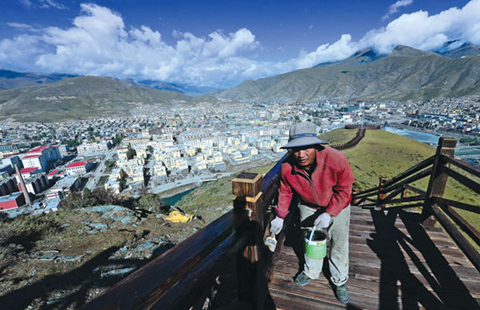Savoring Yangshuo, a jewel under threat
Updated: 2014-08-15 07:24
By James Franklin(China Daily)
|
|||||||||||
On a Beijing morning at 5:35, cracks of light begin to break through the hazy skies. Two hours later, the plane lands in the southern city of Guilin, the Guangxi Zhuang autonomous region, a place that lies in southern China, bordering Vietnam. Through the window I can make out the vague outline of the karst countryside in the morning haze. Its gray complexion is almost see-through, like a pencil sketch that someone had tried to erase, leaving the smudges of graphite on the paper.
Earlier that afternoon, I caught a bus heading farther south, past villages and through the countryside. On the road to Yangdi, a village that embraces the Lijiang River, the lanes were swept with dust. We drove past makeshift stalls spilling over with watermelons on both sides of the road. It was 38 C and the people on the pavement carried umbrellas, wore raincoats and ducked for cover. Bikes and buses, cars and trucks, all woven impulsively along the long road paved with potholes, a tarmacked slalom heading south to the village. All the while the karst limestone mountains, cloaked in green, dotted the countryside.
Later in the day, I loosen a rope, disconnecting an anchor, and the raft I've jumped on starts to rock gaily on the Lijiang River before the motor kicks in and begins to push downstream.
The scenery is art at its most natural; we pass green mountains as we flow along the river. The waters are calm with occasional ripples.
People come here to escape urban China, to swap the chaos of the concrete jungle for tranquility among the mountains. The river carries a steady stream of tourists on rafts and larger cruise liners. The sound of the water is drowned by the buzzing and humming of motors.
Yangshuo is a tourist town with amazing scenery. It's also bustling with bars, shops and especially traffic - both pedestrian and motor. As you wander the county on foot or bike, be prepared to take in both the views and fumes. Easy accessibility to Yangshuo has turned into a booming tourist destination. Yet this success invites pressure - the pressure of sustainable development.
A July 2005 report by the World Tourism Organization highlighted major concerns with the region; the water quality of its rivers, overcrowding from tourism, and fear that rapid changes may alter its green image. According to the report, Yangshuo is located in one of the fastest growing domestic and international tourism markets in the world. Between 1986 and 2004, the number of overnight visitors to the county went from 30,000 annually to 512,000, and 1.75 million passengers rode along the Lijiang River and docked at Yanhshuo in 2004. The region's beauty attracts both opportunities and threats.
It's a simple paradox: Increasing tourism generates increased profit that can be put back into Yangshuo's infrastructure, yet at the same time, increasing tourism weighs heavily on the very infrastructure that needs support.
Yangshuo is home to about 300,000 people, with half living in the town. The story of Yangshuo could become like that of the Italian city of Venice, where 60,000 people live but about 270,000 people call it their home. Mass tourism has driven residents out due to rising rent prices, high cost of living, and lack of jobs outside of tourism. It's been dubbed a "heritage theme park". In 2009, Venice residents that remained in the historical city held a "funeral" to symbolize the death of their city.
Yangshuo's challenge isn't as severe, but the town can learn from the effects that an imbalance of tourism can have upon a historical region. If sustainable development is ignored, the very scenery and atmosphere loved by residents and travelers alike may wither away.
jamesfranklin@21stcentury.com.cn
(China Daily 08/15/2014 page20)
Today's Top News
China, Russia to lay joint gas pipeline
Rules set for HK chief vote
Militia guards US embassy in Libya
450 Pakistans injured in clash with police
My China Story: 'You've got talent'
China's east and west in concert
Putin calls for talks on state system in Ukraine
IMF chief Lagarde investigated in graft case
Hot Topics
Lunar probe , China growth forecasts, Emission rules get tougher, China seen through 'colored lens', International board,
Editor's Picks

|

|

|

|

|

|





